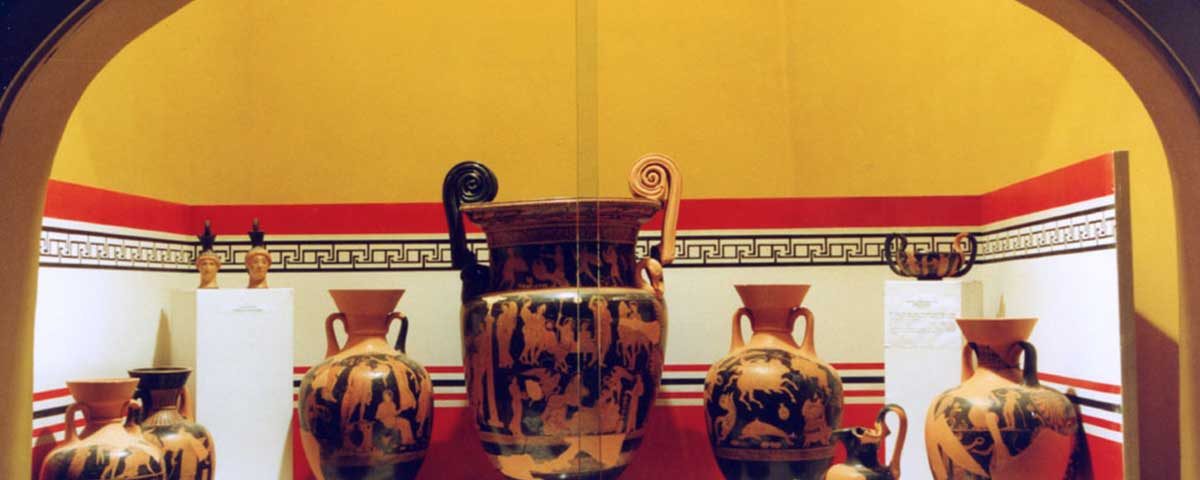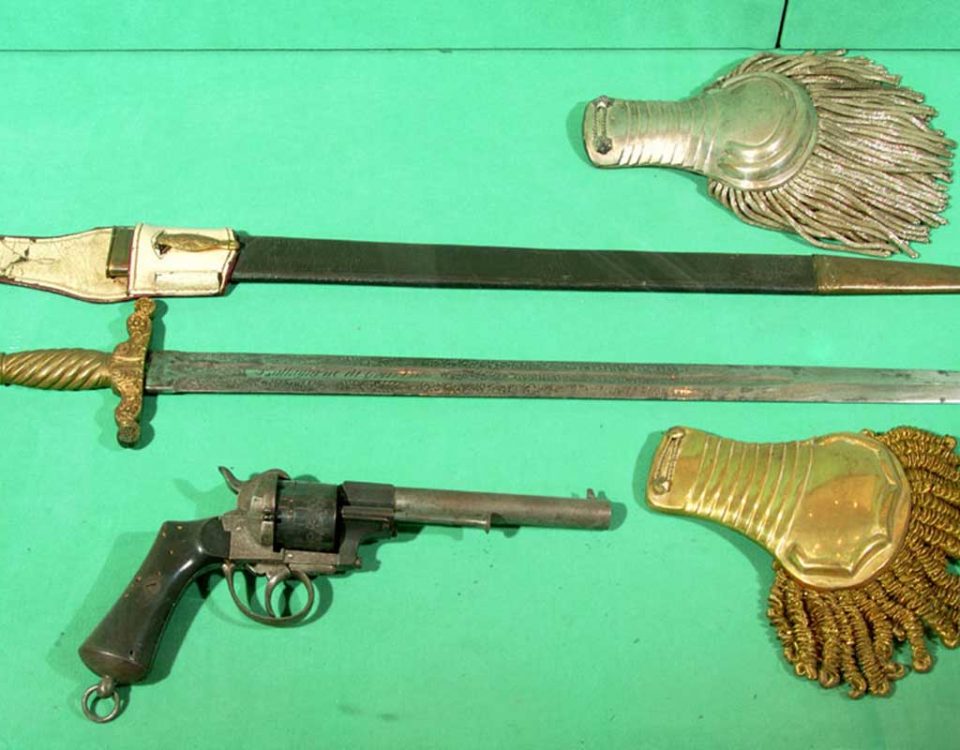- library art gallery ceramics carriages folklore artifacts
The Museum Ettore Pomarici Santomasi Foundation is located in
Via Museo n. 20, Gravina in Puglia (Ba), Italia
how to reach us
+39 080.325.10.21
info@fondazionesantomasi.it
Orari
Mon/Fri: 9.00-13.00 | 16.00-19.00
Saturday: 10.00-13.00 | 16.00-19.00
Sun./Holidays: 10.00-13.00
ARCHEOLOGICAL EXHIBITION
ARCHEOLOGICAL EXHIBITION “ARISTOCRACY AND MYTH”
The “Ettore Pomarici Santomasi” Foundation’s Museum covers the whole 16th century palace owned by the Baron, including all furniture and collections inside it. The second floor basically contains an archeological Exhibition entitled “Aristocracy and Myth”.
Inaugurated last September 2005 in agreement with the Apulian Archeological Superintendence, the permanent Exhibition entitled “Aristocracy and Myth” gave the possibility to expose in Gravina for the first time the most precious finds discovered in various archeological areas of the town, particularly on Botromagno hill. Through the examination of the exposed finds, all datable between the 7th-4th centuries b.C., it could be possible to note the contacts of the local people with the Greeks as demonstrated by small Protocorinthian and Corinthian vases; first signs of social diversity are also evident by other finds: fibulas and amber, ivory and silver adornments.
Colonial vases as well as other archeological finds made by regional populations (Dauni, Enotri and Peuceti) reveal how numerous the contacts were with different populations. The success of this project, increased through the publication of the book “Silbion, form indigenous people to Greek population” by a. Ciancio, stressed some scientific and historical relevant data: together with just few little towns in this region (Ruvo, Ceglie and Rutigliano), Gravina – between 5th-4th centuries b.C. – has the highest concentration of precious and monumental archeological finds with red figures, both Attic and proto-Apulian, discovered in tombs that have aspect and dimensions of a real monument, basically stony semi-rooms with painted walls. It’s the evident sign of the rising of a dominant social class as well as the growing of the central role that had the old Silbion in the former region of Peucezia, its centrality in that intense net of communications and business, its huge wealth and its strict links with the refined Greek culture.
Among the Attic and proto-Italian vases in the tomb nr. 3 / 1994, a great importance has been assigned to a big and rare crater with volutes by the Boreas Painter; the main scene painted on it is an unusual variation of the myth of Iphigénie’s sacrifice. The tomb nr. 1 / 1974 has given new life to an extraordinary group of Attic and proto-Italian vases whose representations on them remind us the Homer world: the dressing of Hector on the kantharos by the Eretria Painter; Bellerophon on an amphora by the Gravina Painter; the hunting of a wild boar and, perhaps, Paris’ legation in Sparta on the big crater with volutes.
Although a part of it was plundered, the tomb nr. 2 / 1994 contains fine vases by the Amykos Painter, particularly an hydria with again an Homeric scene (some heroes defending dying Patroclus, and a crater on which Dionysius, in one of his hysteric ritual, enters the world of immortality. On another crater found in the old San Vito Vecchio St., Hell’s Lord Dionysius invites Heracles at the banquet reserved to his followers before entering the world of the Blessed. Both the exhibitions in Pomarici Santomasi Foundation and those in the local Civic Archeological Museum represent only the prelude to more completed expositions to be arranged for an adequate accommodation of the immense and wealthy archeological heritage of Gravina.
Inaugurated last September 2005 in agreement with the Apulian Archeological Superintendence, the permanent Exhibition entitled “Aristocracy and Myth” gave the possibility to expose in Gravina for the first time the most precious finds discovered in various archeological areas of the town, particularly on Botromagno hill. Through the examination of the exposed finds, all datable between the 7th-4th centuries b.C., it could be possible to note the contacts of the local people with the Greeks as demonstrated by small Protocorinthian and Corinthian vases; first signs of social diversity are also evident by other finds: fibulas and amber, ivory and silver adornments.
Colonial vases as well as other archeological finds made by regional populations (Dauni, Enotri and Peuceti) reveal how numerous the contacts were with different populations. The success of this project, increased through the publication of the book “Silbion, form indigenous people to Greek population” by a. Ciancio, stressed some scientific and historical relevant data: together with just few little towns in this region (Ruvo, Ceglie and Rutigliano), Gravina – between 5th-4th centuries b.C. – has the highest concentration of precious and monumental archeological finds with red figures, both Attic and proto-Apulian, discovered in tombs that have aspect and dimensions of a real monument, basically stony semi-rooms with painted walls. It’s the evident sign of the rising of a dominant social class as well as the growing of the central role that had the old Silbion in the former region of Peucezia, its centrality in that intense net of communications and business, its huge wealth and its strict links with the refined Greek culture.
Among the Attic and proto-Italian vases in the tomb nr. 3 / 1994, a great importance has been assigned to a big and rare crater with volutes by the Boreas Painter; the main scene painted on it is an unusual variation of the myth of Iphigénie’s sacrifice. The tomb nr. 1 / 1974 has given new life to an extraordinary group of Attic and proto-Italian vases whose representations on them remind us the Homer world: the dressing of Hector on the kantharos by the Eretria Painter; Bellerophon on an amphora by the Gravina Painter; the hunting of a wild boar and, perhaps, Paris’ legation in Sparta on the big crater with volutes.
Although a part of it was plundered, the tomb nr. 2 / 1994 contains fine vases by the Amykos Painter, particularly an hydria with again an Homeric scene (some heroes defending dying Patroclus, and a crater on which Dionysius, in one of his hysteric ritual, enters the world of immortality. On another crater found in the old San Vito Vecchio St., Hell’s Lord Dionysius invites Heracles at the banquet reserved to his followers before entering the world of the Blessed. Both the exhibitions in Pomarici Santomasi Foundation and those in the local Civic Archeological Museum represent only the prelude to more completed expositions to be arranged for an adequate accommodation of the immense and wealthy archeological heritage of Gravina.



















